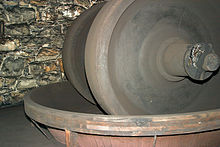Powder mill
Buildings were usually built of stone with one weak wooden wall and roof to direct the force and debris from an accidental explosion toward a river or an open field.
The power canal offered a supply of firefighting water, and the adjacent river was a relatively safe direction to focus explosion debris.
The wagons were often built entirely of wood held together with wooden pegs, and draft animals were usually unshod to avoid sparks from steel shoes or nails.
[2] In 1802, the DuPont family started their industrial enterprises in the United States by building the Eleutherian Mills on the Brandywine Creek in Delaware.
Subsequent production for use in pyrotechnics and antique firearms has been undertaken by smaller firms whose operations are often ended by the persistent hazard of accidental explosions.


